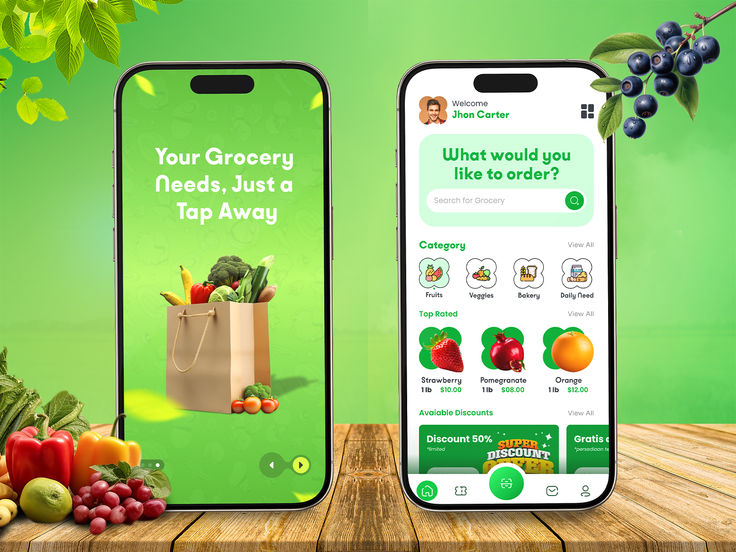Building a Grocery Delivery App Like Instacart: Tech Stack & Features
The growth in on-demand services has shaped modern retail and grocery sectors. A good example of an e-commerce company is Instacart, which lets customers do their grocery shopping online and receive their items at home. Since more and more people are turning to online grocery shopping, businesses and entrepreneurs want to invest in new and innovative grocery apps to stay in the game.
First, learn about the vital features, the right technology and the important role of such a development company if you want to build an app like Instacart. In this article, I will guide you through important steps in grocery delivery app development and how to make sure it succeeds.
Why Invest in Grocery Delivery App Development?
People’s buying habits have changed a lot in recent years. Before buying something, many individuals focus on how easy it is, how long it will take and how safe it is. They address the needs of consumers by making it simple to get the needed grocery goods. According to several reports, the value of the global online grocery market could top hundreds of billions of dollars in the coming decade.
Thanks to Instacart’s achievements, businesses are trying to enter the grocery app market by developing similar apps. Building a feature-rich and scalable mobile app gives startups, supermarket chains, and local grocery stores the opportunity to retain customers and increase profits.
Key Features of a Grocery Delivery App Like Instacart
When developing a grocery delivery app, you must provide a seamless and user-friendly experience. A well-designed app typically consists of three main components: the customer app, the delivery agent app, and the admin panel.
1. Customer App Features:
Customers are the end-users of your platform, and their experience determines your app’s success. Features should include:
- User registration and login (via email or social media)
- Real-time product search and filtering
- Cart management and order scheduling
- Multiple payment options (cards, wallets, cash on delivery)
- Real-time order tracking
- Push notifications for updates and offers
- Ratings and reviews
- Customer support chat or call
2. Delivery Agent App Features:
Delivery agents need tools to manage orders efficiently. Essential features include:
- Order notification and acceptance
- Real-time navigation using maps
- Delivery status updates
- Earnings and performance tracking
- In-app chat or support
3. Admin Panel Features:
The admin panel is the control center for managing operations:
- User and delivery agent management
- Product and inventory management
- Order tracking and analytics
- Payment and commission management
- Promotional tools (offers, coupons, etc.)
In addition, many businesses prefer to go with a Whitelabel Grocery Delivery App to speed up the launch process. A whitelabel solution allows customization of branding, features, and functionalities without building the app from scratch, making it ideal for rapid entry into the market.
Choosing the Right Tech Stack for Grocery App Development
Selecting the right technology stack ensures your app runs smoothly, scales efficiently, and remains secure. Here’s a typical tech stack that a professional grocery delivery app development company might use:
Front-end Technologies:
- iOS App: Swift or Objective-C
- Android App: Kotlin or Java
- Cross-platform: Flutter or React Native (for quicker development and lower cost)
Back-end Technologies:
- Programming Languages: Node.js, Python, or PHP
- Frameworks: Express.js, Django, or Laravel
- Database: PostgreSQL, MongoDB, or MySQL
- Cloud Hosting: AWS, Google Cloud, or Microsoft Azure
APIs and Integrations:
- Payment Gateways: Stripe, PayPal, Razorpay
- SMS/Push Notifications: Firebase Cloud Messaging (FCM), Twilio
- Maps & Navigation: Google Maps API, Mapbox
- Analytics: Google Analytics, Firebase Analytics
Choosing the right stack depends on your project’s complexity, budget, scalability needs, and the expertise of your grocery app development company.
Whitelabel vs Custom Grocery Delivery App Development
When planning your project, one of the biggest decisions is whether to build a custom app or use a readymade grocery app. Each approach has its advantages:
- Custom Development: Offers complete flexibility to build features tailored to your business model. Ideal for long-term growth and unique value propositions but takes more time and investment.
- Whitelabel Grocery Delivery App: A readymade solution that can be quickly rebranded and customized. It significantly reduces time-to-market and development costs, making it perfect for startups or businesses wanting a quick launch.
A reliable grocery app development company will help you weigh these options and choose the right path based on your goals.
Importance of Partnering with the Right Grocery App Development Company
Working with an experienced grocery app development company is crucial to the success of your project. Such companies offer end-to-end development services, from ideation to deployment and post-launch support. They can help you:
- Define the scope and strategy of your app
- Design a user-friendly interface
- Choose the right tech stack
- Develop and test the application across devices
- Ensure data security and compliance
- Provide ongoing maintenance and feature upgrades
Look for a company with a proven track record in grocery delivery app development, client testimonials, and expertise in scalable architecture and UI/UX design.
Conclusion
Building a grocery delivery app like Instacart is a smart move in today’s digitally connected world. Whether you’re a retailer expanding online or an entrepreneur entering the grocery market, investing in the right features and tech stack is essential. Depending on your needs and budget, you can choose between a custom app and a readymade grocery app.
Partnering with a capable grocery app development company or a team offering Whitelabel Grocery Delivery App solutions can fast-track your journey. Ultimately, your success depends on offering a reliable, user-friendly, and scalable platform that meets customer demands and stands out in a competitive market.

